
Контрольна робота
для студентів 4 курсу ІЗДН
Варіант 1
R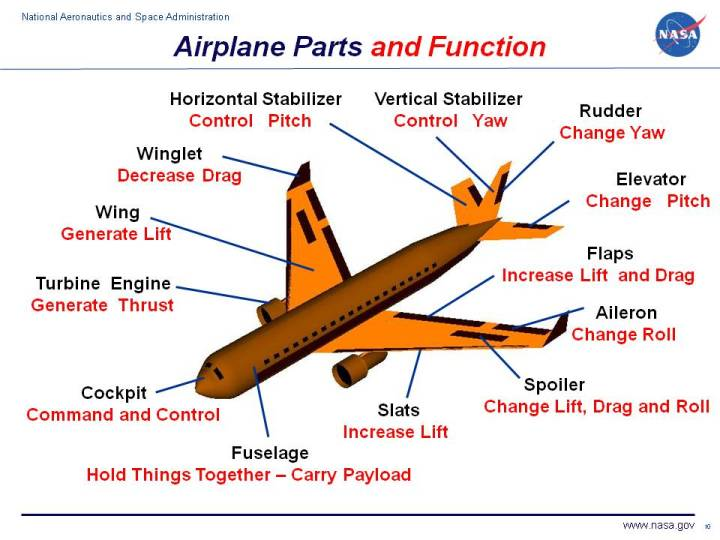 ead
and translate the following text into Ukrainian.
ead
and translate the following text into Ukrainian.
The Parts of an Airplane
Introduction to the Airplane
Airplanes come in many different shapes and sizes depending on the mission of the aircraft, but all modern airplanes have certain components in common. These are the fuselage, wing, tail assembly and control surfaces, landing gear, and powerplant(s).
For any airplane to fly, it must be able to lift the weight of the airplane, its fuel, the passengers, and the cargo. The wings generate most of the lift to hold the plane in the air. To generate lift, the airplane must be pushed through the air. The engines, which are usually located beneath the wings, provide the thrust to push the airplane forward through the air.
The fuselage is the body of the airplane that holds all the pieces of the aircraft together and many of the other large components are attached to it. The fuselage is generally streamlined as much as possible to reduce drag. Designs for fuselages vary widely. The fuselage houses the cockpit where the pilot and flight crew sit and it provides areas for passengers and cargo. It may also carry armaments of various sorts. Some aircraft carry fuel in the fuselage; others carry the fuel in the wings. In addition, an engine may be housed in the fuselage.
The wing provides the principal lifting force of an airplane. Lift is obtained from the dynamic action of the wing with respect to the air. The cross-sectional shape of the wing as viewed from the side is known as the airfoil section. The planform shape of the wing (the shape of the wing as viewed from above) and placement of the wing on the fuselage (including the angle of incidence), as well as the airfoil section shape, depend upon the airplane mission and the best compromise necessary in the overall airplane design.
The control surfaces include all those moving surfaces of an airplane used for attitude, lift, and drag control. They include the tail assembly, the structures at the rear of the airplane that serve to control and maneuver the aircraft and structures forming part of and attached to the wing.
The tail usually has a fixed horizontal piece (called the horizontal stabilizer) and a fixed vertical piece (called the vertical stabilizer). The stabilizers provide stability for the aircraft—they keep it flying straight. The vertical stabilizer keeps the nose of the plane from swinging from side to side (called yaw), while the horizontal stabilizer prevents an up-and-down motion of the nose (called pitch). (On the Wright brothers' first successful aircraft, the horizontal stabilizer was placed in front of the wings. Such a configuration is called a canard after the French word for "duck").
The hinged part found on the trailing edge of the wing is called the aileron. It is used to roll the wings from side to side. Flaps are hinged or pivoted parts of the leading and/or trailing edges of the wing used to increase lift at reduced airspeeds, primarily at landing and takeoff. Spoilers are devices used to disrupt the airflow over the wing so as to reduce the lift on an airplane wing quickly. By operating independently on each wing, they may provide an alternate form of roll control. Slats at the front part of the wing are used at takeoff and landing to produce additional lift.
At the rear of both the aileron surfaces and elevators and rudders are small moving sections called trim tabs that are attached by hinges. Their function is to (1) balance the airplane if it is too nose heavy, tail heavy, or wing heavy to fly in a stable cruise condition; (2) maintain the elevator, rudder, and ailerons at whatever setting the pilot wishes without the pilot maintaining pressure on the controls; and (3) help move the elevators, rudder, and ailerons and thus relieve the pilot of the effort necessary to move the surfaces.
The landing gear, or undercarriage, supports the airplane when it is resting on the ground or in water and during the takeoff and landing. The gear may be fixed or retractable. The wheels of most airplanes are attached to shock-absorbing struts that use oil or air to cushion the blow of landing. Special types of landing gear include skis for snow and floats for water. For carrier landings, arrester hooks are used.
Forward motion, or thrust, is generated by a thrust-producing device or powerplant to sustain flight. The powerplant consists of the engine (and propeller, if present) and the related accessories. The main engine types are the reciprocating (or piston type), and the reaction, or jet, engine such as the ram jet, pulse jet, turbojet, turboprop, and rocket engine. The propeller converts the energy of a reciprocating engine's rotating crankshaft into a thrust force. Usually the engines are located in cowled pods hung beneath the wings, but some aircraft, like fighter aircraft, will have the engines buried in the fuselage.
Other configurations have sometime been used. For instance, the Wright brothers' 1903 Flyer had pusher propellers (propellers at the rear of the plane) and the elevators at the front of the aircraft. Many fighter aircraft also combine the horizontal stabilizer and elevator into a single stabilator surface. There are many possible aircraft configurations, but any configuration must provide for the four forces needed for flight.
Exercise 1. Match the word to the appropriate definition.
1. spoilers |
A) a part along the back edge of an aircraft's wing which can be moved to help the aircraft turn or to keep it level |
2. engine |
B) a device which helps an aircraft, ship or vehicle to balance |
3. landing gear |
C) a flat piece of wood or metal at the back of a boat or aircraft, which is moved from side to side in order to control the direction of travel |
4. fuselage |
D) If an aircraft or ship yaws, it moves slightly to the side of its intended direction |
5. stabilizer |
E) a device on a car or aircraft which is positioned so that it stops the air from flowing around the vehicle in a smooth way and so helps to control it |
6. yaw |
F) the main body of an aircraft |
7. aileron |
G) the set of wheels and other parts which support a plane when it is on the ground and make it possible to take off and land |
8. flap |
H) part of the back of an aircraft wing which can be moved up or down to help the aircraft go up or down |
9. wing |
I) a machine that uses the energy from liquid fuel or steam to produce movement |
10. rudder |
J) the flat part of the body which a bird, insect or bat uses for flying, or one of the flat horizontal structures that stick out from the side of an aircraft and support it when it is flying |
Exercise 2. Translate into Ukrainian.
The cross-sectional shape of the wing as viewed from the side is known as the airfoil section.
Flaps are hinged or pivoted parts of the leading and trailing edges of the wing used to increase lift at reduced airspeeds, primarily at landing and takeoff.
The power plant consists of the engine and the related accessories.
On powered aircraft, one or more aircraft engines are propulsion units that provide thrust to push the aircraft forward through the air.
A wing with an airfoil cross-section shape, used to generate aerodynamic lifting force to support the aircraft in flight by deflecting air downward as the aircraft moves forward.
The horizontal stabiliser (also known as tailplane) is usually mounted near the rear of the fuselage, or at the top of the vertical stabiliser, or sometimes a canard is mounted near the front of the fuselage for the same purpose.
A fixed-wing aircraft, typically called an aeroplane, airplane or simply plane, is an aircraft capable of flight using forward motion that generates lift as the wing moves through the air.
Most fixed-wing aircraft are flown by a pilot on board the aircraft, but some are designed to be remotely or computer controlled.
Planes include jet engine and propeller driven vehicles propelled forward by thrust, as well as unpowered aircraft (such as gliders), which use thermals, or warm-air pockets to inherit lift.
The fuselage carries the human flight crew if the aircraft is piloted, the passengers if the aircraft is a passenger aircraft, other cargo or payload, and engines and/or fuel if the aircraft is so equipped.
Exercise 3. Fill in the correct word / word combination (from the box below).
range takeoff equipment distance aircraft maximal powered landing extra fuel tanks maximal |
The _______total range is the _________an aircraft can fly between _______and________, as limited by fuel capacity in __________aircraft, or cross-country speed and environmental conditions in unpowered aircraft.
______ range means the maximum ______the aircraft can fly. This usually means maximum fuel load, optionally with ______________ and minimum__________. It refers to transport of _______for use on remote location.
Exercise 4. Write the correct form of the word in brackets and complete the sentences.
International commercial air travel (reach) levels of safety and convenience which (be unimaginable) just a generation ago. Although almost always extremely tragic events, the lessons from accidents (play) an important role in the process (continue) (improve) this safety.
This Lessons Learned from Aviation Accidents library (represent) some of the most major accidents and their (relate) lessons. The U. S. Federal Aviation Administration, with support from many others, (plan) to continue adding to this material on an annual basis. The (object) is (populate) the material with many more of the most historically significant, policy shaping accidents, in order that the lessons that can be learned from their review may be available to all users of the library.
Exercise 5. Look at the following picture. Fill in the blanks.


B. cockpit - where the pilots fly the plane, located at the front of the plane.
C. door - allows people to enter and exit the plane.
D. elevator - the movable part of the 2 horizontal parts of the tail section that moves up or down to help the plane remain level during flight (the elevator controls pitch) and helps control altitude.
E. fin - the vertical part of the rear of the tail. The rudder is located on the trailing edge of the fin.
F. flaps - the hinged, rear edge of a wing (located near the body of the plane); the flaps move downwards during takeoff and landing in order to increase the wing surface and therefore increase lift.
G. fuselage - the body of the airplane (excluding the wing and tail). Passengers and cargo are carried towards the rear of the fuselage.
H. jet engines - the part of the aircraft that provides the power for the flight.
I. landing gear - the retractable wheels fastened to the main part of the body (by struts) - it is used for landing and moving the plane around on the ground.
J. nose - the forward part of the plane.
K. nosewheel - the part of the landing gear located under the nose of the plane.
L. rudder - the vertical part of the tail; it can move left/right to stabilize the airplane during takeoffs and landings in strong wind or in crosswinds (it controls yaw).
M. slats - the hinged forward edge of a wing; the slats are used during takeoff and landing in order to increase the wing surface and therefore increase lift.
N. spoiler - small hinged plates located on the top surface of the wings; spoilers are used to slow an aircraft or help it descend by disrupting (spoiling) the flow of air around the wing, increasing the drag.
O. windows - sealed viewing portals, located along the sides of the plane.
P. wing - the airplane's two wings produce lift as the plane moves through the air. The wings have four moveable controls: ailerons, flaps, slats, and spoilers.
Контрольна робота для студентів 4 курсу іздн
Варіант 2
Read and translate the following text into Ukrainian.
The dynamics of airplane flight
A ir
is a physical substance which has weight. It has molecules which are
constantly moving. Air
pressure
is created by the molecules moving around. Moving air has a force
that will lift kites and balloons up and down. Air is a mixture of
different gases; oxygen,
carbon dioxide and nitrogen.
All things that fly need air. Air has power to push and pull on the
birds, balloons, kites and planes. In 1640, Evangelista
Torricelli discovered that air has weight.
When experimenting with measuring mercury,
he discovered that air put pressure on the mercury.
ir
is a physical substance which has weight. It has molecules which are
constantly moving. Air
pressure
is created by the molecules moving around. Moving air has a force
that will lift kites and balloons up and down. Air is a mixture of
different gases; oxygen,
carbon dioxide and nitrogen.
All things that fly need air. Air has power to push and pull on the
birds, balloons, kites and planes. In 1640, Evangelista
Torricelli discovered that air has weight.
When experimenting with measuring mercury,
he discovered that air put pressure on the mercury.
Francesco Lana used this discovery to begin to plan for an airship in the late 1600s. He drew an airship on paper that used the idea that air has weight. The ship was a hollow sphere which would have the air taken out of it. Once the air was removed, the sphere would have less weight and would be able to float up into the air. Each of four spheres would be attached to a boat-like structure and then the whole machine would float. The actual design was never tried.
How Wings Lift the Plane
Airplane wings are curved on the top which make air move faster over the top of the wing. It moves slower underneath the wing. The slow air pushes up from below while the faster air pushes down from the top. This forces the wing to lift up into the air.
Laws of Motion
Sir Isaac Newton proposed three laws of motion in 1665. These Laws of Motion help to explain how a plane flies.
If an object is not moving, it will not start moving by itself. If an object is moving, it will not stop or change direction unless something pushes it.
Objects will move farther and faster when they are pushed harder.
When an object is pushed in one direction, there is always a resistance of the same size in the opposite direction.
F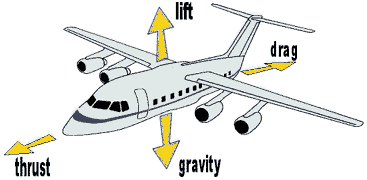 our
Forces of Flight
our
Forces of Flight
Lift - upward
Drag - down and backward
Weight - downward
Thrust - forward
Controlling the Flight of a Plane
How does a
plane fly? If we place one wing down and one wing up we can use the
roll to change the direction of t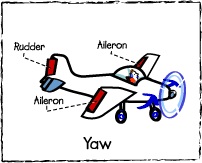
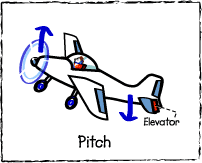 he
plane. We are helping t
he
plane. We are helping t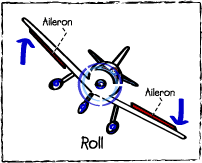 o
turn the plane by yawing toward one side. If we raise the nose of the
plane, we are raising the pitch of the plane. All these dimensions
together combine to control the flight of the plane. A pilot of a
plane has special controls: there are levers
and buttons that the pilot can push to change the yaw, pitch and roll
of the plane.
o
turn the plane by yawing toward one side. If we raise the nose of the
plane, we are raising the pitch of the plane. All these dimensions
together combine to control the flight of the plane. A pilot of a
plane has special controls: there are levers
and buttons that the pilot can push to change the yaw, pitch and roll
of the plane.
To roll the plane to the right or left, the ailerons are raised on one wing and lowered on the other. The wing with the lowered aileron rises while the wing with the raised aileron drops.
Pitch is to make a plane descend or climb. The pilot adjusts the elevators on the tail to make a plane descend or climb. Lowering the elevators caused the airplane's nose to drop, sending the plane into a down. Raising the elevators causes the airplane to climb.
Yaw is the turning of a plane. When the rudder is turned to one side, the airplane moves left or right. The airplane's nose is pointed in the same direction as the direction of the rudder. The rudder and the ailerons are used together to make a turn.
How does a Pilot Control the Plane?
To control a plane a pilot uses several instruments:
The pilot controls the engine power using the throttle. Pushing the throttle increases power, and pulling it decreases power.
The ailerons raise and lower the wings. The pilot controls the roll of the plane by raising one aileron or the other with a control wheel. Turning the control wheel clockwise raises the right aileron and lowers the left aileron, which rolls the aircraft to the right.
T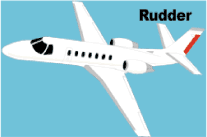
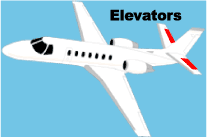 he
rudder
works
to control the yaw of the plane. The pilot moves rudder left and
right, with left and right pedals. Pressing the right rudder
pedal moves
the rudder to the right. This yaws the aircraft to the right. Used
together, the rudder and the ailerons are used to turn the plane.
he
rudder
works
to control the yaw of the plane. The pilot moves rudder left and
right, with left and right pedals. Pressing the right rudder
pedal moves
the rudder to the right. This yaws the aircraft to the right. Used
together, the rudder and the ailerons are used to turn the plane.
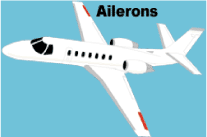
The elevators which are on the tail section are used to control the pitch of the plane. A pilot uses a control wheel to raise and lower the elevators, by moving it forward to backward. Lowering the elevators makes the plane nose go down and allows the plane to go down. By raising the elevators the pilot can make the plane go up.
The pilot of the plane pushes the top of the rudder pedals to use the brakes. The brakes are used when the plane is on the ground to slow down the plane and get ready for stopping it. The top of the left rudder controls the left brake and the top of the right pedal controls the right brake. If you look at these motions you can see that each type of motion helps control the direction and level of the plane when it is flying.
Sound Barrier
Sound is made up of molecules of air that move. They push together and gather together to form sound waves. Sound waves travel at the speed of about 750 mph at sea level. When a plane travels the speed of sound the air waves gather together and compress the air in front of the plane to keep it from moving forward. This compression causes a shock wave to form in front of the plane.
In order to travel faster than the speed of sound the plane needs to be able to break through the shock wave. When the airplane moves through the waves, it is makes the sound waves spread out and this creates a loud noise or sonic boom. The sonic boom is caused by a sudden change in the air pressure. When the plane travels faster than sound it is traveling at supersonic speed. A plane traveling at the speed of sound is traveling at Mach 1 or about 760 mph. Mach 2 is twice the speed of sound.
Regimes of Flight
Sometimes called speeds of flight, each regime is a different level of flight speed.
Example |
Regimes of Flight |
Seaplane |
General Aviation (100-350 MPH). Most of the early planes were only able to fly at this speed level. Early engines were not as powerful as they are today. However, this regime is still used today by smaller planes. Examples of this regime are the small crop dusters used by farmers for their fields, two and four seater passenger planes, and seaplanes that can land on water. |
Boeing 747 |
Subsonic (350-750 MPH). This category contains most of the commercial jets that are used today to move passengers and cargo. The speed is just below the speed of sound. Engines today are lighter and more powerful and can travel quickly with large loads of people or goods. |
Concorde |
Supersonic (760-3500 MPH - Mach 1 - Mach 5). 760 MPH is the speed of sound or MACH 1. These planes can fly up to 5 times the speed of sound. Planes in this regime have specially designed high performance engines. They are also designed with lightweight materials to provide less drag. The Concorde is an example of this regime of flight. |
Space Shuttle |
Hypersonic (3500-7000 MPH - Mach 5 to Mach 10). Rockets travel at speeds 5 to 10 times the speed of sound as they go into orbit. An example of a hypersonic vehicle is the X-15, which is rocket powered. The space shuttle is also an example of this regime. New materials and very powerful engines were developed to handle this rate of speed. |
Exercise 1. Using a monolingual dictionary of aviation or encyclopaedia, please, find the definition of the following words and word combinations.
Molecule, airfoil, forces of flight, lift, drag, thrust, weight, gravity, roll, pitch, yaw, rudder, lever, ailerons, elevator, throttle, brake, regimes of flight, flight speed, to be curved.
Exercise 2. Fill in the blanks with a suitable word or phrase.
1. The air moves faster over the ...
2. … the plane to the right or left, the ailerons are raised on one wing and lowered on the other.
3. … is to make a plane descend or climb.
4. … is the turning of a plane.
5. The pilot controls the engine power using the ...
6. The … raise and lower the wings.
7. The … works to control the yaw of the plane.
8. The … which are on the tail section are used to control the pitch of the plane.
9. The … are used when the plane is on the ground to slow down the plane and get ready for stopping it.
10. Each regime is a different level of ...
Exercise 3. Translate into Ukrainian.
1. All things that fly need air. Air has power to push and pull on the birds, balloons, kites and planes.
2. Airplane wings are curved on the top which make air move faster over the top of the wing.
3. A pilot of a plane has special controls that can be used to fly the plane. There are levers and buttons that the pilot can push to change the yaw, pitch and roll of the plane.
4. Pushing the throttle increases power, and pulling it decreases power.
5. The pilot of the plane pushes the top of the rudder pedals to use the brakes.
Exercise 4. Match the word to the most appropriate translation.
|
Exercise 5. Match the word in column A with those in column B in order to make an appropriate word combination, as in the example and provide a translation. Example: sources of power – джерела живлення
|




